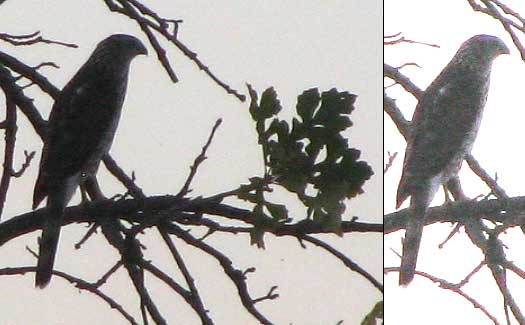Excerpts from Jim Conrad's
Naturalist Newsletter
from the December 9, 2012 Newsletter issued from the valley of the Dry Frio River in northern Uvalde County, southwestern Texas, on the southern border of the Edwards Plateau; elevation ~1750m (~5750 ft); N29.62°, W99.86°; USA
SHARP-SHINNED HAWK AT DUSK
As the dusk walk ended and the sky shed just enough light for things to appear as silhouettes, a small raptor glided fast onto a branch of a nearly leafless oak tree and looked around. The bird was so small that at first I thought he was a Kestrel, or Sparrow Hawk, but Kestrels have more rounded, thicker-necked bodies, plus, remembering how the hawk had glided in on rounded wings held straight out from his body, not with pointed, swooped-back wings like the Kestrel's, I figured it was our smallest accipiter-type hawk, the Sharp-shinned Hawk Accipiter striatus. Below you can see his silhouette, with a PhotoShop-overexposed image of the same silhouette at the right revealing the barred tail and streaked underparts of an immature bird:

My field guide gives the Sharp-shinned's length as 10½ inches (27cm), which can be compared to the Red-tailed Hawk's length of 18 inches (46cm).
Sharp-shinned Hawks often show up at midday soaring over the valley's extensive pastures. Early and late in the day they tend to fly low over the trees hoping to surprise small to medium-sized birds, which it preys on.
from the December 21 2003 Newsletter issued from the woods just south of Natchez, Mississippi, USA
SHARP-SHINNED HAWK
Most mornings nowadays a certain Sharp-shinned Hawk, ACCIPITER STRIATUS, visits during my campfire breakfasts. Sometimes he sails by at treetop level but other times he dips low and streaks down the alley between the barn and the wall of Loblolly Pine saplings, passing right by me. He's always traveling from north to south, so I suspect that each day he's just "making his rounds."
During summers Sharp-shinned Hawks prefer coniferous and mixed conifer-aspen-birch forests, so our wintry Loblollies must look friendly to them. Since their prey is small to medium-size birds, I expect my breakfast visitor mostly eats White-throated Sparrows and Swamp Sparrows, since these are the main species in our Loblolly Field. My field guide says "They take their prey in sudden, swift attacks from inconspicuous perches, or during fast, stealthy flights through the woods." I can attest to this latter fact, for several times I've been following a woodland trail when one came around the corner and surprised me as much as I surprised him.
from the October 6, 2006 Newsletter issued from the woods just west of Natchez, Mississippi, USA
SHARP-SHINNED HAWKS MIGRATING
All summer up in Kentucky I've been seeing a Sharp-shinned Hawk zoom through the neighborhood from time to time, often very close to the ground and sometimes perching in the old Blacklocust snag where in late summer juvenile Purple Martins stretched and preened. Now I'm seeing Sharp-shinneds down here, too, though during past summers in the Natchez area I never saw them. It all makes sense because in central Kentucky Sharp-shinned Hawks are found year-round, but down here they're just winter visitors. The ones I'm seeing now down here have just arrived for the winter.
Sharp-shinned Hawks are bird-eaters. Maybe 90-97% of their food consists of birds ranging in size from warblers to American Robins. Cornell University's page on the species provides a picture plus a lot of life-cycle information on the species at http://www.birds.cornell.edu/bfl/speciesaccts/shshaw.html.